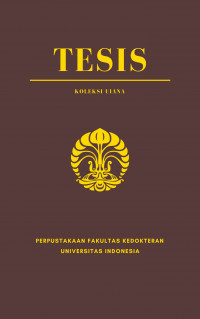Tesis
Perbandingan Nasal Intermittent Positive Pressure Ventilation Dengan Nasal Continuous Positive Pressure Sebagai Terapi Awal Sindrom Gawat Napas Sejak Di Ruang Bersalin = Comparison Between Nasal Intermittent Positive Pressure Ventilation And Nasal Continuous Positive Pressure As The Initial Treatment Of Respiratory Distress Syndrome In The Delivery Unit.
Latar belakang: Nasal CPAP dini sebagai standar bantuan napas untuk mengatasi sindrom gawat napas telah diketahui, namun masih ada 30-80 % kegagalan terapi NCPAP untuk mencegah penggunaan ventilator mekanik. NIPPV dilaporkan lebih mampu menurunkan kegagalan bantuan napas non invasif dibandingkan NCPAP, tetapi beberapa penelitian lain menyatakan bahwa tidak ada perbedaan dalam kegagalan terapi antara NCPAP dan NIPPV. Sampai saat ini belum ada penelitian uji klinik terkendali yang membandingkan NIPPV dengan NCPAP sejak di ruang bersalin Tujuan: Penelitian ini untuk mengetahui apakah pengunaan NIPPV dini sejak di ruang bersalin sebagai terapi awal sindrom gawat napas pada bayi prematur, mampu menurunkan kegagalan terapi non invasif dibanding dengan NCPAP. Metode: Uji acak terkendali tidak tersamar ganda, pada bayi dengan usia gestasi > 28 sampai < 35 minggu dengan sindrom gawat napas yang tidak membutuhkan intubasi subyek saat resusitasi, di randomisasi untuk mendapatkan NCPAP atau NIPPV sejak dari ruang bersalin. Terdapat 52 subyek bayi yang terandomisasi 27 pada kelompok NCPAP dan 25 pada kelompok NIPPV, dengan berat badan lahir 1.513+374 gram vs 1522+411 gram, usia gestasi 32+1,5 minggu vs 32+1,7 minggu. Hasil : Proporsi subyek dalam kelompok NCPAP yang gagal terapi terdapat 16 bayi (59,2%) sedangkan di kelompok NIPPV terdapat 2 bayi (8,0%) dengan RR 0,135 (IK 95% 0,040- 0,619) dengan p =0,025. Dari kelompok NCPAP subyek yang memerlukan intubasi sebanyak 7 bayi (26%) sedangkan di NIPPV sebanyak 2 bayi (12%). Terdapat 9 bayi dalam kelompok NCPAP yang membutuhkan bantuan NIPPV dalam 72 jam pertama, dan semuanya terhindar dari pemakaian ventilasi mekanik Simpulan: penggunaan NIPPV dini sejak dari ruang bersalin dapat menurunkan kegagalan terapi non invasif pada bayi prematur dibandingkan NCPAP
Kata kunci: NCPAP, NIPPV, Sindrom gawat napas, prematur, kamar bersalin
Background: Early nasal CPAP has been proven to be an effective therapy for respiratory distress syndrome in neonates. However, 30-80% of this intervention fails to avoid the use of mechanical ventilator. Some studies report that NIPPV is a more preferable approach compared to NCPAP, but the results remain conflicting. There are no randomized clinical trials of using NIPPV compare to NCAP in the delivery room. Objective: The aim of this study was to determine the efficacy of early NIPPV as an initial therapy for respiratory distress compared to early NCPAP in premature neonates. Methods: This is a randomized, controlled, single blind study. Subjects included neonates with a gestational age between 28 until less than 35 weeks with respiratory distress syndrome that did not require intubation at resuscitation. Patients were randomized into NCPAP and NIPPV since in the delivery room, immediately after birth. Twenty-seven infants randomized to NCPAP and 25 comparable infants to NIPPV, with birth weight 1.513+374 gram vs 1.522+411 gram, and gestational age 32+1,5 week vs 32+1,7 week. Results: A higher number of premature neonates eventually failed NCPAP in the control group compared to the NIPPV group (59.2% vs. 8.0%, RR 0,135 (IK 95% 0,040 - 0,619), p = 0.025. There were 26% subjects in the NCPAP group that required intubation, as opposed to only 12% in the NIPPV group. Additionally, there were 9 subjects in the NCPAP group that required NIPPV in the first 72 hours, all of whom did not require mechanical ventilation. Conclusion: The use of early NIPPV after birth was found to reduce the intervention failure of non-invasive methods compare with NCPAP
Keywords: NCPAP, NIPPV, Respiratory distress sundrome, delivery room
- Judul Seri
-
-
- Tahun Terbit
-
2020
- Pengarang
-
Juliani - Nama Orang
RISMA KERINA KABAN - Nama Orang
Hanifah Oswari - Nama Orang - No. Panggil
-
T20228fk
- Penerbit
- Jakarta : Sp-2 Ilmu Kesehatan Anak., 2020
- Deskripsi Fisik
-
xvii, 83 hal; ill; 21 x 30 cm
- Bahasa
-
Indonesia
- ISBN/ISSN
-
-
- Klasifikasi
-
NONE
- Edisi
-
-
- Subjek
- Info Detail Spesifik
-
-
| T20228fk | T20228fk | Perpustakaan FKUI | Tersedia |


Masuk ke area anggota untuk memberikan review tentang koleksi